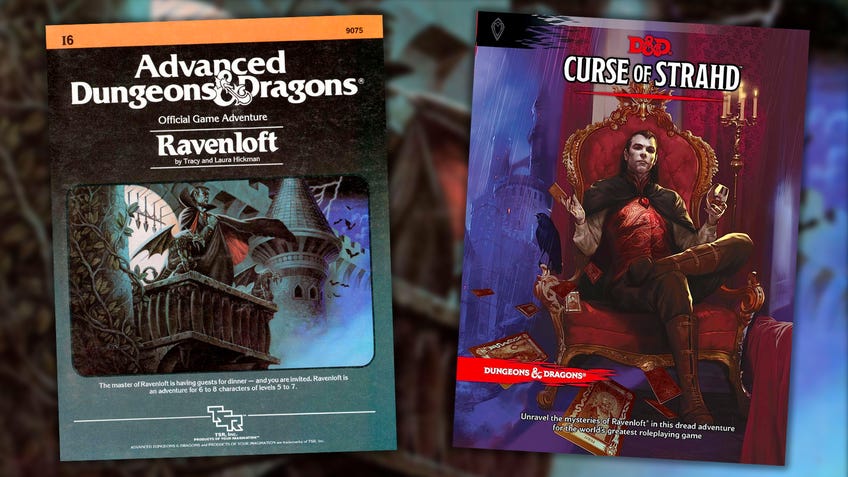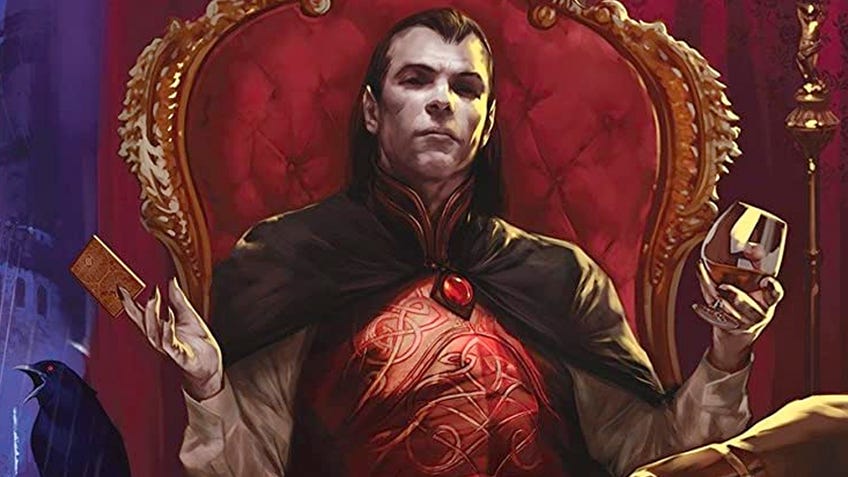After Honor Among Thieves, the next D&D movie should be all about Strahd - here’s why
The villainous vampire would provide plenty for fans - and film-makers - to sink their teeth into.
The marketing for Dungeons & Dragons: Honor Among Thieves has put some of D&D’s most iconic creations at the forefront. Mimics, owlbears, displacer beasts and even the plump dragon Themberchaud are all set to make an appearance in the upcoming film. So when movie studio Paramount begins developing the sequel, it would make perfect sense for it to focus on the roleplaying game’s most iconic monster: Count Strahd von Zarovich.
The villainous vampire has been feeding on adventurers since first-edition D&D, where he appears in the 1983 adventure module I6: Ravenloft. Believing the vampire archetype had been reduced to yet another wandering monster, authors Laura and Tracy Hickman set out to create a villain that was compelling enough to deserve his own setting. Drawing upon Bram Stoker’s Dracula and Bela Lugosi’s depiction in the 1931 movie, the two eventually created the decadent predator Strahd, who resides in Castle Ravenloft and preys on the innocent people of Barovia.
Since then, Strahd has appeared in almost every edition of D&D. His legend has expanded with each iteration, including the D&D 5E adventure module Curse of Strahd and setting book Van Richten’s Guide to Ravenloft. All of these appearances provide a tremendous supply of source material for a Count Strahd feature film.
Picture this: two interwoven storylines, one depicting Strahd’s rise to power and descent into vampirism, the other portraying a party of adventurers assaulting Castle Ravenloft to end Strahd’s tyranny. The movie would switch between the past and present storylines, showing Strahd as the powerful vampire he is while revealing how he took on the curse of undeath.
Strahd's appearances in almost every edition of D&D provide a tremendous supply of source material for a feature film.
Strahd’s past starts out strangely heroic. Born a prince, Strahd spends much of his life leading armies on the battlefield. During these conflicts, Strahd gathers a band of comrades to fight at his side, including the dusk elf Rahadin and the psionic inquisitor Ulmed. Their campaign would culminate in defeating the lich Osybus and his army of soul-devouring cultists before eventually settling in the valleys of Barovia.
At this point, Strahd’s story is that of an epic adventurer traveling the land and slaying foes, not unlike a typical D&D player character. But when he encounters someone he cannot conquer, Strahd’s true nature is revealed.

Tatyana is another piece of the Ravenloft mythos that has existed since the beginning. Strahd falls in love with the beautiful Barovian, but Tatyana’s affection is ultimately given to Strahd’s younger, more compassionate brother Sergei. Strahd becomes jealous of Sergei, and that jealousy leads Strahd to seek out a way to reclaim his lost youth in a vain attempt to win Tatyana’s heart.
What happens next varies with each edition. Perhaps Strahd makes a deal with Death itself, as he does in the fictional memoir I, Strahd. Or perhaps he finds a tomb filled with forgotten gods imprisoned in amber, as in Curse of Strahd. Whatever the source, Strahd learns the secret to becoming a master vampire.
It is here the story takes a tragic turn. In a rage, Strahd murders Sergei and drinks his blood. When Tatyana witnesses the act, she flees from Strahd and ultimately hurls herself off a castle balcony, choosing to plunge to her death rather than become a prisoner of Strahd’s twisted love. In this moment of despair, Strahd is slain by his own castle guards, only to rise again as a vampire.
Cut between these scenes of Strahd’s past would be the present-day storyline of adventurers encountering Strahd at his most villainous. These heroes could be the Honor Among Thieves party, spirited away to Barovia by the same creeping fog that captures players in Curse of Strahd.
In the current state of cinema where anti-heroes reign, a capital-V Villain is sorely needed.
Or they could be the monster hunters of Ravenloft, like the vampire slayer Rudolph van Richten and his apprentice Ez d’Avenir. Either party could encounter the archmage Mordenkainen, who was originally the player character for the late co-creator of D&D, Gary Gygax.
Whichever protagonists face down Strahd, what matters is that Strahd comes face-to-face with the consequences of his evil deeds. By this point in his story, Strahd has murdered his brother, driven away his comrade Ulmed, corrupted Rahadin and doomed his domain to darkness and despair. He cares for nothing except sadism and the hope that Tatyana will magically reincarnate into another victim of his obsession.

In the current state of cinema where anti-heroes reign, a capital-V Villain is sorely needed. Strahd’s tale is tragic, but it is a tragedy of his own creation. After Tatyana’s demise, he has no qualms with feeding on the innocent and laughing maniacally. If Paramount truly wants to bring the most iconic parts of Dungeons & Dragons to the silver screen, then the next film should put Strahd front-and-centre.
There’s just one more question: who should play him?











